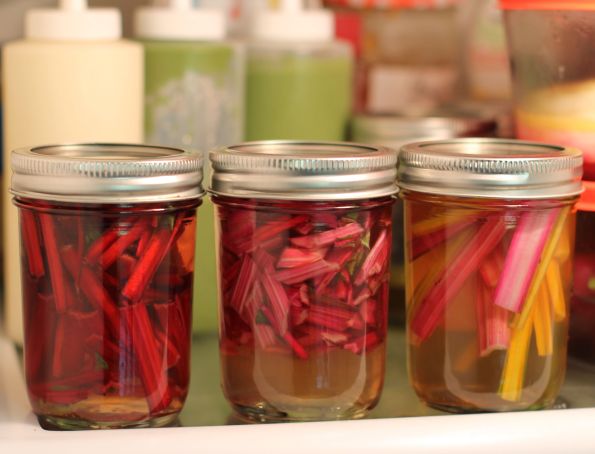i love pickles.
I’ve been eating pickles my whole life, starting with the sweet gherkins that graced the relish tray at our Thanksgiving table. My sister and I would crunch on tangy Vlasic dill spears, found only in the refrigerated section; their claim for crunchiness rested on the fact that they were “kept cold,” not put on warm shelves where they would go soft . We ate dill pickles with the turkey sandwiches my mother dutifully packed in the red cooler for sporting events and tournaments that started early and went well into the day. When I was in high school, my father’s friend, “Dog,” as he is known around the small town I grew up in, brought over his own pickle creation, a spear that was neither dill nor sweet, seasoned with garlic and clove and other spiced I had never tasted before. As a chef, I have a difficult time describing the flavor of these pickles because they’re something like a combination of sweet and dill, perhaps approaching pickle nirvana, “the pinnacle of all pickles.” They’re not really garlicky, but they’re not sweet either. They’re just really good.
Pickling has become a more popular culinary trade as scores of people across the country pickle anything from blueberries to turnips and everything in between. On a road trip through Texas last summer, I picked up a few jars of pickled okra, two to share with friends and one to keep. Pickled okra is a special treat; if you’ve never experienced it, I’d highly recommend seeking out a jar and then adding them to your next bloody mary. Each spring, I combine the popular “giardiniera” veggies with olives, roasted garlic, and olive oil to make a salad which graces a muffaletta calzone, a nod to my love of New Orleans in celebration of Mardi Gras. This “salad” is rich with olive oil and roasted garlic with a spicy, crunchy tang from the veggies; a good dose of meaty saltiness comes from the olives.
Truthfully, I’ve never met a pickle that I don’t like. And truthfully, I’ve never made my own pickles. Until now.
I have an obsession with Martha Rose Shulman, food writer for the New York Times column “Recipes for Health” and author of “The Very Best Recipes for Health.” The title of her column, “Recipes for Health,” at first made me think it would be too healthy, a collection of food that is more healthy than delicious. My personal motto lies somewhere between “it better taste good” and “if it doesn’t, I’m not eating it.” And while “healthy” is something I strive for in most of my cooking, a dish first and foremost must be pleasing to my palate. By my estimation, Ms Shulman is always cranking something healthy and delicious out of her kitchen, and it is my hope one day to be friends – or dare I say – neighbors with her, close enough that I might just pop over and see what she’s creating in her kitchen on a random Thursday afternoon. Before this gets weird, let’s get back to why I’ve mentioned her in the first place.
Ms. Shulman recently wrote a column about pickling. She chronicles her adventures in pickling numerous spring veggies, from baby turnips and radishes to carrots and cauliflower. And she also talks about pickling chard stems. Whaaaaat? Chard stems? First, let’s get clear on what chard stems actually are. Swiss chard is a dark, leafy green, cousin to kale and collards, with the visual upper hand: chard stems are gorgeously colored, from bright yellow to hot pink to an orange bordering on neon. If you’ve ever seen chard, you’d remember it. The conundrum is this: cook with the leaves, and do what with those gorgeous stems? I save them every single time, dutifully separating the leafy green from the more fibrous, crunchy stem; at the very least, these different textures would not cook at the same rate, so they need to be separated and treated as such. I put the chard stems back into the fridge, with the best intention of whirling them into a smoothie or throwing them into a stir fry. Even if I make either of these dishes, which I do not do often, I almost always remember the chard stems as I’m drinking my last gulp of my strawberry smoothie.
Sigh.
So the chard stems typically end up in the trash, which is a shame because I really don’t want to waste them, I want to cook them and eat them and I want to be a better person. And now Martha Rose Shulman has given me a reason. Pickled chard stems. The answer to all of my prayers. Well, not really, but I really am knocking out two challenges at once: making pickles and using my chard stems.
So here they are, in my fridge, beautifully preserved and waiting at least 2 days for me to dig in and eat them. I was unsure of the best way to cut them, so I cut them into three different shapes and thought I’d see which way I prefer best. And to make sure I would have enough “pickle juice,” I doubled her recipe. I had a jar of leftover juice, so maybe I will go pickle crazy and make a jar of something else tomorrow. Please do check back, as I will be updating with my verdict next week, certain to include more discussion about pickles and chard. And if you’re curious, here is a link to her recipe in case you too have a bag of chard stems lurking in your fridge.


2 Comments
Leave a CommentTrackbacks